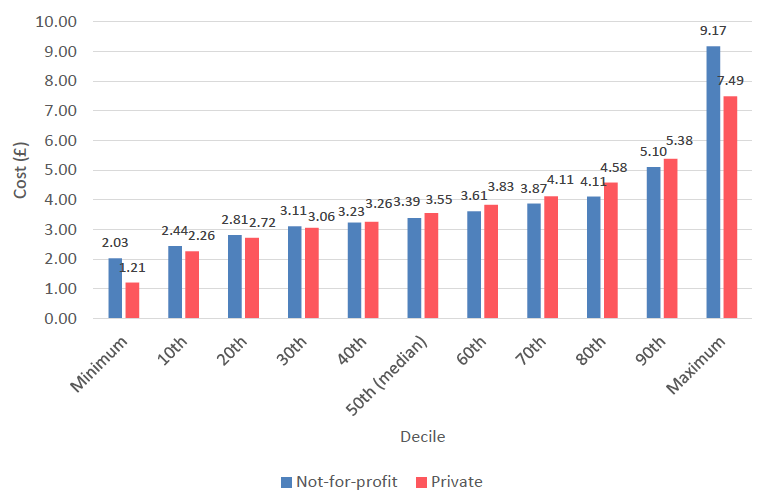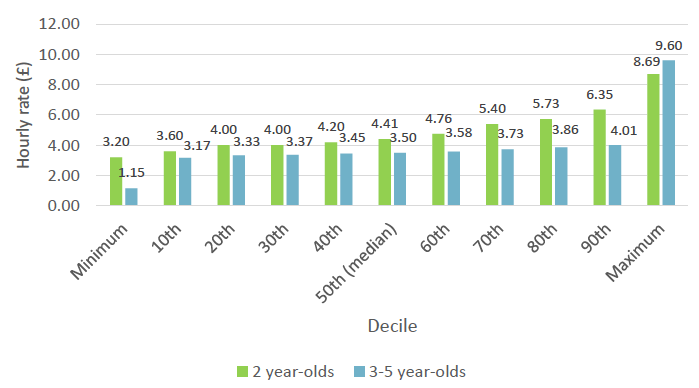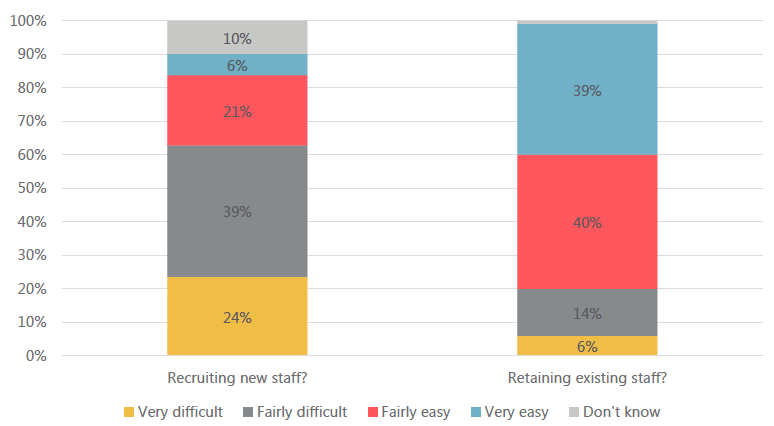Cost of early learning and childcare provision in partner provider settings
Data on the costs and income associated with providing early learning and childcare (ELC) among private and not-for-profit ‘partner providers’.
4 Summary of main findings
As discussed in Chapter 1, the purposes of this study was primarily to provide detailed estimates of the costs to private and not-for-profit providers of providing ELC in Scotland in order to inform further modelling by the Scottish Government to support the extension of government-funded ELC. As such, this report is intended primarily to provide technical information about how these estimates were arrived at, rather than to provide more substantive analysis or interpretation of the findings. However, in the interests of facilitating further dialogue around future expansion, this chapter includes a very brief summary of some of the key findings. Given the relatively small sample size for some sub-groups, and the greater caution that needs to be applied to any analysis based on these sub-groups, these key findings are presented primarily at the overall level (although in a few cases findings for private and not-for-profit providers are presented separately).
4.1 An 'average' partner provider
- The main focus of the analysis was on providing unit costs per hour of ELC provided, which is discussed in the following section. However, to set the context and give some idea of the 'average' provider, the table below shows the average (mean) annual costs (overall and for the two biggest cost categories - staff costs and rent/mortgage), as well as the mean total number of childcare hours provided and the mean number of children 0-5 providers are registered to take.
- Not-for-profit providers tend to have lower annual costs, reflecting the fact that, on average, they provide fewer hours to fewer children compared with private partner providers.
- The cost categories incurred by private and not-for-profit providers also vary - for example, most not-for-profit providers surveyed did not incur business rates, while on average private providers paid over £6,000 a year in business rates.
Table 4. 1: 'Average' characteristics of partner providers
| Not-for-profit partner provider | Private partner provider | |
|---|---|---|
| Total annual costs | £107,505 | £303,406 |
| Staff costs | £77,961 | £204,905 |
| Mortgage/Rent | £4,493 | £21,975 |
| Total hours ELC provided | 30,056 | 88,167 |
| Children registered to take | 36 | 56 |
4.2 Overall costs of providing ELC
- The overall estimated average (mean) cost to providers of providing one hour of ELC to 0-5 year-olds was £3.70. Figure 1 shows the composition of this figure in terms of different cost components. Staff costs clearly account for the lions share - 71% of the total cost.
- The cost estimates are an average across 0-5 year-olds. Because of the higher costs associated with younger children (for example, due to higher adult-child ratios), the average unit cost of providing ELC to 0-2 year-olds will be higher than £3.70, and for 3-5 year-olds will be lower.
Figure 1: Composition of mean ELC costs per child, per hour

Sample size = 173
- The median estimated costs per hour was slightly lower, at £3.49. However, the responses of providers who participated in the survey indicated a relatively wide range of estimated costs around this median. Among private providers, costs ranged from a minimum of £1.21 an hour to a maximum of £7.49, while among not-for-profit providers they ranged from £2.03 to £9.17 (Figure 2).
Figure 2: Distribution of estimated ELC costs per child, per hour (deciles), by provider type

Sample size: Not-for-profit = 61; Private = 112.
- Estimated mean full-time salaries across all providers were: £23,169 for a manager, £16,771 for an early years supervisor, and £14,520 for an early years practitioner.
- Only 37% of partner providers surveyed (44% of private and 23% of not-for-profit) currently contribute to a pension scheme for any staff. Auto-enrolment may therefore have a significant impact on this element of their costs.
4.3 Rates paid for government funded ELC places
- The average (mean) hourly rate providers reported being paid by Councils for government-funded ELC provision for two year-olds was £4.78, while the mean reported rate for 3-5 year-olds was £3.59. Again, there were quite wide ranges of reported hourly rates around these averages, as shown in Figure 3. While average rates are similar to those identified elsewhere, 14 the extreme ends of the spectrum are not consistent with other unpublished evidence. [15]
Figure 3: Distribution of reported hourly ELC rates paid by Councils (deciles), by provider type

Sample size: Two year-olds = 62; 3-5 year-olds = 157
Base: All providers who had any children in the relevant age category registered for government-funded places and who gave a response when asked about rates paid by their local council.
4.4 Fees for ELC
- The average (mean) fees partner providers charged to parents per hour (based on weekly fees where given, or daily, half-day or hourly fees where not) were £4.09 for two year-olds, £3.93 for three year-olds, and £3.87 for four year-olds. [16]
- Exactly what is included in these fees varies across providers. For example, only 28% of providers indicated that nappies and wipes were included in their fees (Table 4.2). Lunchtime food and snacks were more likely to be included in fees charged by private providers (63%) than by not-for-profit providers (34%).
Table 4.2: Additional charges
| Nappies and wipes | Lunch and snacks | Additional play activities/trips | |
|---|---|---|---|
| Included in fee | 28% | 53% | 65% |
| Charged for separately | 0% | 32% | 30% |
| Parents bring in | 70% | 13% | - |
4.5 Staff qualifications
- All practitioners working in daycare services for children are required to have or be working towards an appropriate qualification at SCQF level 6 - equivalent to an SVQ level 3. In addition, managers are now expected to have or to be working towards an SCQF level 9 qualification (equivalent to degree level or SVQ level 4). [17]
- Two-thirds (66%) of providers responding to this survey indicated that all their ELC staff were qualified to at least SVQ level 3, while a further quarter (26%) indicated that over three quarters of their staff were qualified to this level.
- Assuming that where any staff were qualified to SVQ level 4 this would include the manager, most (86%) of partner providers responding to the survey had a manager qualified to the equivalent of degree level.
4.6 Beliefs about the future
- While partner providers were broadly optimistic about the ease of retaining their existing staff, they were less positive about the ease of recruiting appropriately qualified new staff - 63% reported finding it very or fairly difficult to recruit suitable new staff (Figure 4).
- In terms of plans for the future, most (66%) partner providers expect to stay the same size in the next year, 17% expected to expand, 7% to get smaller, and 1% to close down altogether. Private partner providers were slightly more likely to be planning expansion (19% compared with 14% of not-for-profit providers).
- Partner providers expressed very mixed views on how confident they felt about their ability to accommodate the planned expansion of government funded hours from the current 600 to 1,140 by 2020. While half (51%) were very or fairly confident, 41% were not very or not at all confident, and 8% were unsure.
Figure 4: Partner provider beliefs about ease of staff recruitment and retention

4.7 Childminder costs
A very small sample of childminders were interviewed for this study, and the range of costs they identified was relatively wide. There may be a need for further research to better understand their costs. However, based on this limited sample (n = 10), childminders had average outgoings of £1.55 per childcare hour, with an average income (hourly fee) of £4.29. Average annual income after costs was under £10,000 per childminder.
Contact
Email: Sasha Maguire, Sasha.maguire@gov.scot
There is a problem
Thanks for your feedback